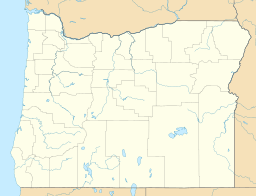Hole-in-the-Ground facts for kids
Quick facts for kids Hole-in-the-Ground |
|
|---|---|
| Highest point | |
| Elevation | 4,650 ft (1,420 m) |
| Geography | |
| Location | Lake County, Oregon, U.S. |
| Parent range | Cascades |
| Topo map | USGS Hole In The Ground |
| Geology | |
| Mountain type | maar |
| Last eruption | about 50,000 to 100,000 years ago |
Hole-in-the-Ground is a huge maar. A maar is a special kind of volcano crater. It was formed by a powerful explosion when hot magma met underground water. This amazing natural feature is found in Lake County, central Oregon, in the U.S.. It's located northeast of Crater Lake, not far from Oregon Route 31.
Contents
What is Hole-in-the-Ground?
Hole-in-the-Ground is a very large volcanic crater. It looks like a giant bowl in the ground. This crater is part of the Fort Rock-Christmas Lake Valley Basin. It's a great example of how powerful nature can be.
How Big is This Crater?
Hole-in-the-Ground is quite impressive in size. It measures about 1 mile (1,600 meters) across. It's a bit longer from north to south than from east to west.
The bottom of the crater is about 490 feet (150 meters) lower than the land around it. The rim, or edge, of the crater rises between 115 to 213 feet (35 to 65 meters) above the surrounding ground. The highest part of this rim is on the east side.
How Did Hole-in-the-Ground Form?
This giant hole was created a very long time ago, during a period called the late Pleistocene epoch. This was between 13,500 and 18,000 years ago. At that time, the area where Hole-in-the-Ground is now was near the shore of a large lake called the Fort Rock Basin.
The crater formed when hot, melted rock, called basaltic magma, moved close to the surface of the Earth. When this super-hot magma met underground water, the water instantly turned into steam. This steam built up a huge amount of pressure.
Eventually, the pressure became so great that it caused a massive explosion. This blast blew out all the rock and soil above it, along with some new volcanic material. As the ground collapsed into the newly formed hole, it sealed the vent. Then, the process would repeat, leading to another explosion. This happened many times, eventually creating the enormous Hole-in-the-Ground we see today. Some pieces of rock as big as 26 feet (8 meters) were thrown as far as 2.3 miles (3.7 kilometers) away from the crater!
Nearby Volcanic Features
To the west of Hole-in-the-Ground, there's an even bigger maar called Big Hole. It measures about 1.1 miles (1,820 meters) across. However, Big Hole is much older and has been worn down more by weather and time.



